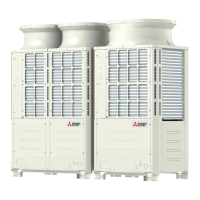What does Error Code 5201 mean on a Mitsubishi Electric PUHY-P168 Air Conditioner?
- EEdward HowardSep 7, 2025
If your Mitsubishi Electric Air Conditioner is showing Error Code 5201, it indicates a high-pressure sensor fault (63HS1).

What does Error Code 5201 mean on a Mitsubishi Electric PUHY-P168 Air Conditioner?
If your Mitsubishi Electric Air Conditioner is showing Error Code 5201, it indicates a high-pressure sensor fault (63HS1).
What does Error Code 6608 mean on a Mitsubishi Electric PUHY-P168 Air Conditioner?
If your Mitsubishi Electric Air Conditioner displays Error Code 6608, it indicates a no response error.
What does Error Code 6602 mean on a Mitsubishi Electric PUHY-P168 Air Conditioner?
If your Mitsubishi Electric Air Conditioner displays Error Code 6602, it indicates a transmission processor hardware error.
What does Error Code 6606 mean on a Mitsubishi Electric PUHY-P168?
If your Mitsubishi Electric Air Conditioner displays Error Code 6606, it indicates a communication error between the device and transmission processors.
What does Error Code 2600 mean on a Mitsubishi Electric PUHY-P168?
If your Mitsubishi Electric Air Conditioner is showing Error Code 2600, it indicates water leakage.
What does Error Code 5101 mean on a Mitsubishi Electric PUHY-P168?
If your Mitsubishi Electric Air Conditioner is showing Error Code 5101, it indicates a temperature sensor fault.
What does it mean when my Mitsubishi Electric PUHY-P168 displays Error Code 4250 or 4255?
Error Codes 4250 and 4255 on your Mitsubishi Electric Air Conditioner indicate several potential issues: an instantaneous overcurrent, a short-circuited IPM/ground fault, an overcurrent error due to a short-circuited motor, or simply an overcurrent situation.
What does Error Code 4102 mean on a Mitsubishi Electric PUHY-P168 Air Conditioner?
If your Mitsubishi Electric Air Conditioner is showing Error Code 4102, it indicates an open phase.
What does Error Code 6603 mean on a Mitsubishi Electric PUHY-P168 Air Conditioner?
If your Mitsubishi Electric Air Conditioner displays Error Code 6603, it indicates a transmission line bus busy error.
What does Error Code 7130 mean on a Mitsubishi Electric PUHY-P168 Air Conditioner?
If your Mitsubishi Electric Air Conditioner displays Error Code 7130, it indicates an incompatible unit combination.
| Brand | Mitsubishi Electric |
|---|---|
| Model | PUHY-P168 |
| Category | Air Conditioner |
| Language | English |
Covers reading manuals, handling refrigerant leaks, and general warnings.
Details safe installation practices, cable usage, and electrical work requirements.
Lists necessary tools, materials, and specifies piping requirements and handling.
Covers brazing, air tightness tests, vacuum drying, and refrigerant charging procedures.
Explains refrigerant properties, composition, pressure, and notes on refrigerating machine oil.
Defines system compatibility, maximum cable lengths, and types.
Details DIP switch functions and address settings for system components.
Provides sample system connection diagrams and explains wiring methods.
Specifies allowable pipe lengths and sizes for various system configurations.
Identifies major components and shows refrigerant circuit diagrams for outdoor units.
Details the control board, INV board, fan board, noise filter, and transformer box.
Compares functions and specifications of MA and ME remote controllers.
Explains group settings, interlock settings, and using the built-in temperature sensor.
Provides the detailed electrical wiring diagram for the outdoor unit.
Shows the electrical wiring diagram for the transmission booster.
Illustrates refrigerant flow for PUHY-P72, P96, and P120 models.
Explains the function and specifications of key refrigerant circuit components.
Details DIP switch functions and factory settings for unit control.
Explains control methods, startup sequences, bypass control, and emergency operation modes.
Provides flowcharts for indoor and outdoor unit operation modes.
Outlines checks before and the method for performing a test run.
Covers refrigerant amount adjustment, calculation formulas, and standard operation data.
Lists and defines error codes, their causes, and troubleshooting steps.
Details troubleshooting for transmission issues, components like sensors, valves, fans, and inverter modules.
Explains how to interpret LED displays for various operating conditions and error codes.











